The Apple Thunderbolt Display Review
by Anand Lal Shimpi on September 23, 2011 2:56 AM EST- Posted in
- Displays
- Mac
- Apple
- Thunderbolt
- Thunderbolt Display
Dissection
If you haven't gathered by now, the Thunderbolt Display isn't a regular monitor - it has a lot of components inside that you'd typically only find in a full fledged computer. Being the curious cat I am, I wanted to see inside. Apple isn't too fond of us poking around inside their review samples, but luckily the Crabtree Valley Mall Apple Store just got Thunderbolt Displays in so I hopped in the practical-wagon and grabbed one in the name of science.
Apple has an incredible fascination with using magnets in its designs. What it enables are some pretty neat enclosures, particularly on its displays. The glass front of the Thunderbolt Display is actually identical to what's used on the 27-inch LED Cinema Display and iMac. The glass is held to the chassis via several very strong magnets. To remove the glass you'll need to use suction cups:
Behind the glass front is the actual LCD panel itself. The LCD and backlight are enclosed in a single unit. What we're interested in is behind the LCD however. Unplug a few cables and remove a grounding screw and the LCD unit is easily cast aside. Behind it are two discrete PCBs:
The PCB on the left is the monitor's power supply. Looking at another half-wave rectifier isn't on my to-do list this time, so we turn our attention to the right PCB. This is the board that handles all of the IO on the Thunderbolt Display. All of the screws we've removed thus far just need a T9/T10 torx bit.
The Thunderbolt Display's motherboard is full of controllers driving all of the rear facing IO ports. Contrary to what we originally posted, I now believe this is the same Light Ridge controller we've seen on other Macs (not the MacBook Air):
The external Thunderbolt cable actually continues inside the display and ends up at an internal Thunderbolt port. The cable terminates at the port and then is routed via traces on the PCB to the Eagle Ridge chip:
The other controllers are sprinkled around the PCB, although there's enough space between all of them to make routing nice and easy. The beauty of designing PCBs for monitors like this is you have tons of room to work with.
Pericom provides a PCIe x1 to 4-USB-port adapter on the board:
The internal speakers are driven by a combination of an ST-NXP 0161ET USB audio controller and an Analog Devices ADAV4601 audio processor. The ST-NXP controller sits on an internal USB interface, while the ADAV4601 dangles off of it.
That wraps it up for the front of the PCB. Around back there's a collection of stereo amps as well as the GigE (Broadcom BCM57761) and FW800 (LSI L-FW643E-2) controllers.
There's nothing immediately apparent in the PCB design that would point to the cause of the issue we saw with the Promise Pegasus interfering with the Thunderbolt Display's USB audio controller. The root cause must be exclusive to the Pegasus.








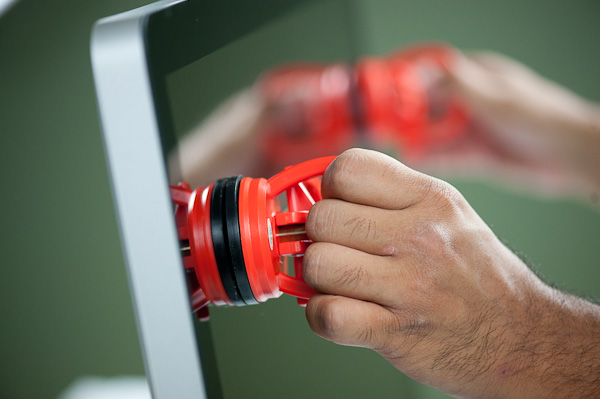
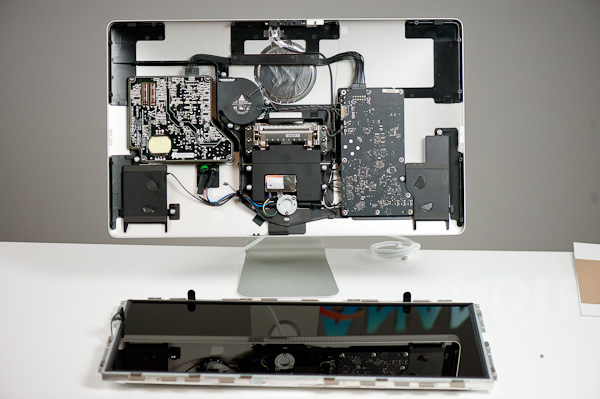
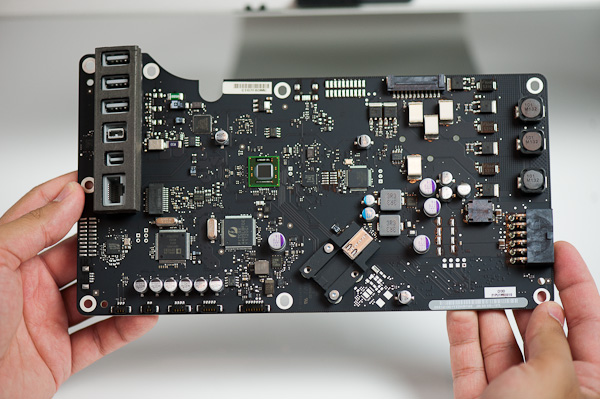
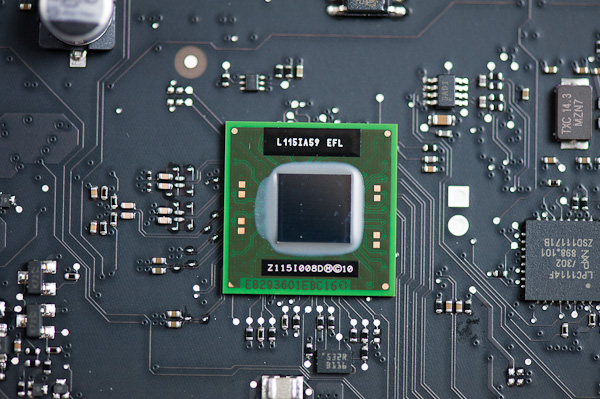
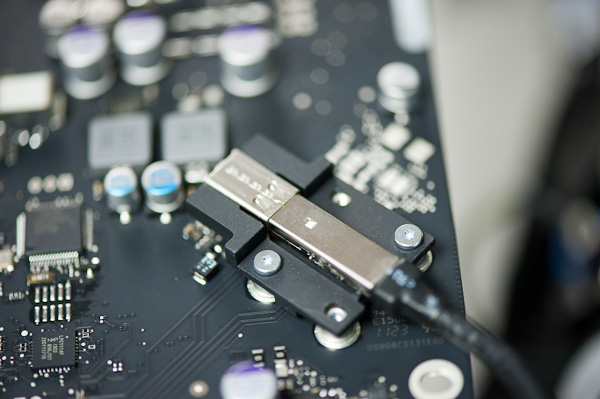
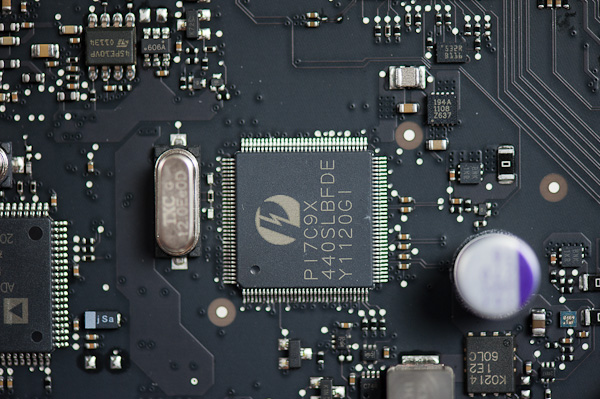
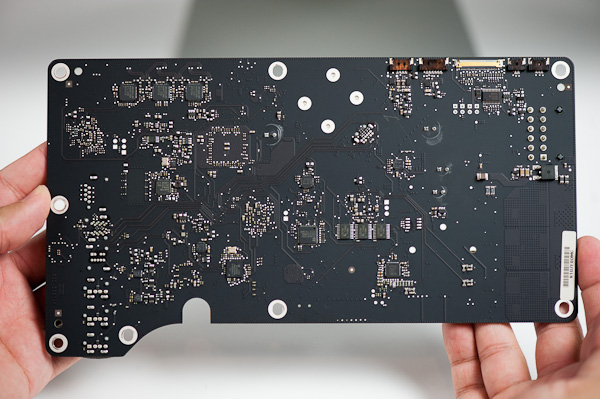
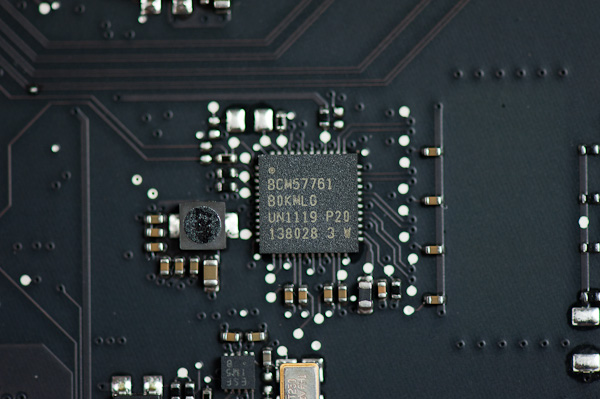








275 Comments
View All Comments
Omid.M - Saturday, September 24, 2011 - link
Anand to smile at the camera and point to the lower right of the screen at a QR code that launches a mail client with a URL to the review...to share with others. Oops, thinking outloud.@moids
You get my email a while back, Anand? I know you've been slammed with your schedule!
nameless_1 - Saturday, September 24, 2011 - link
You could have this ten years ago without plugging any cables at all, not even two. Just buy a docking station for your laptop. Or is the news that it is finally possible on a Mac...ufon68 - Saturday, September 24, 2011 - link
Awesome video.Death666Angel - Saturday, September 24, 2011 - link
"Thanks to SSDs, Turbo Boost and Thunderbolt the only thing holding notebooks back from being true desktop replacements is GPU performance."And the fact that performance per buck is still about 3 to 5 times worse than any desktop PC. Unless you are very well off or need a notebook for your work, chances are, you can't afford a real desktop replacement notebook.
tommyj - Saturday, September 24, 2011 - link
A typical i5 laptop, which is like $600 (Thinkpad Edge), basically does what a typical desktop does extremely well and comes with a keyboard, pointing device, and screen if you are really destitute. As Anand said, the only thing holding them back is the GPU and frankly a lot of people cannot really use one properly (if you don't play games and don't dabble with professional applications, its going to sit idle). Spend another $100-250 and you can throw a very nice SSD to make it feel really snappy.If you want to bring up Apple, the base Macbook Air is like $1000 and its powerful enough for every task people need to do. For most users, even those who use their machines for prosumer purposes, processor speed becomes less of a necessity but a luxury really.
Increasingly, people are finding desktops less and less worthwhile. The only reason I still own, and upgrade, mine is because it can hold the latest and greatest GPU.
bigpics - Saturday, September 24, 2011 - link
As someone else pointed out to me, notebook performance, especially light-weight notebook performance is changing on more important variables more quickly than monitor tech.So this monitor suggests a new cost effective strategy for a one-machine-to-do-it-all setup. This should work out well as long as you don't need the latest, latest performance bumps in the MBP line while on the road (or the top iMac performance at home).
The strategy is to buy the best MB Air + this monitor, and then replace the CPU piece every year or two - when the available air performance will stay equivalent to the performance of a one or two year old pro. (And note that while some performance is incrementally sacrificed, portability is incrementally increased - AND you get this gorgeous screen - which might meet some users' needs better in the first place.)
Here's a current high-end MBP 15":
$2,999.00
2.2GHz Quad-core Intel Core i7
8GB 1333MHz DDR3 SDRAM - 2x4GB
256GB Solid State Drive
SuperDrive 8x (DVD±R DL/DVD±RW/CD-RW)
MacBook Pro 15-inch Hi-Res Glossy Widescreen Display
And here's a current high-end MBA 13.3" INCLUDING the Thunderbolt monitor:
$2777.00
Apple Thunderbolt Display (27-inch) ($999)
MBA 13.3" ($1778)
1.8GHz Dual-Core Intel Core i7
4GB 1333MHz DDR3 SDRAM
256GB flash storage
External Apple MacBook Air SuperDrive
Of course some of you might need and be able to get both the MBP and the monitor - lucky you, but let's say you have SOME real world budget constraints, and over the next six years, you replace the MBA twice (at 2 and 4 years in) as it advances, and the MBP once (3 years in).
Assuming constant prices - not entirely unreasonable with Apple speculation - and a 6 year usable lifetime for the monitor (even though it will certainly be upgraded with, say, USB 3 and more - but the same cost to replace in either strategy), here's your total bill (exclusive of other peripherals, cables, etc.):
1. You have this monitor and a three year old MBP 15":
$6997 spent.
(Add the cost of iPads if the MBP is just too much for some outings and you need something lighter)
2. You have this monitor and two year old MBA (of whatever "):
$6333 spent.
So a reasonable approach I would say (and even wonder if Apple's not encouraging it in some ways). Consider one last comparison - your best stay at home (no notebook capabiity) iMac options. And we'll specify that some of you will want more net and more capable apps on the road than you can get on your phone, so you'll meet your away from home needs with three baseline iPads over the 6 years
3. So here's for two top of the line iMacs and possible iPads:
$6798 spent on iMacs
$1497 on iPads
$ 8295 spent
One more cost saving (over a height adjustable desk) possiblity: a. Old phone books (free) and b) height adjustable chairs (a few hundred more at most).
sreams - Saturday, September 24, 2011 - link
When you close the Macbook Air, you aren't "sleeping" it. You're just closing it.dsumanik - Sunday, September 25, 2011 - link
nice production sound, and dialogue on the video..well done.Some problems though unfortunately:
"Personally, I use a height adjustable desk as I find it helps me avoid any carpal tunnel pain. Combined with a height adjustable chair, the lack of height adjustment on the display doesn't bother me."
Uh huh.
I should buy this display and get an adjustable desk.
Thats the OBVIOUS solution.
Not only a facepalm by apple's designers...(i mean how hard would it be to make it adjustable a few inches?) but also a total facepalm in the pro apple bias department.
This review was a commercial for apple, plain and simple.
Why not start accepting payment from apple?
You might as well if you gonna be a part of thier marketing team.
Your own words:
"a must have item for macbook owners"
PFFFFFFFFFFFFFFFTTTTT.
ill save people the 15 minute advertisement;
pros:
single cable to connect and charge
nice material and design
cons:
-no sound
-no usb 3
-incompatible with anything but 2011 macbooks
-1000 dollars (i could buy 5 1920x1080 displays for same price)
-you need to buy an adjustable desk and chair
Amazing what you can sell people if it comes in a nice shiny package...even a seasoned, unpaid, objective and intelligent reviewer fell for it hook line and sinker.
hey apple if you reading this...
Where my integrated iphone dock?
Constructor - Sunday, September 25, 2011 - link
He simply said that he had that anyway, so the lack of height adjustability didn't bother him.
And I shudder to think how heavy and still wobbly a height-adjustable stand would have to be for my 27" iMac. The TBD is not quite as heavy, but I rather live with an additional socket to get it to the desired height for me than dealing with the usual wobbly mechanism I know from other monitors (such as the secondary Samsung next to the iMac, which also needs an additional stand to get it high enough). I'm rather tall and most adjustable stands end too low anyway, so there would be no benefit for me anyway.
Quite hard to make it really sufficient. Just "a few inches" are worthless. Inclination adjustment is enough for that. And making an iMac 27" or a TBD adjustable by the amount I really needed would make the stand very wobbly and/or very heavy and very wide.
This is a lot more difficult than you seem to get.
"Pfft" indeed. You completely misrepresent what Anand actually said: "For MacBook Air owners who don't have options for these high speed interfaces to begin with, the Thunderbolt Display is a must-have."
Further: For me the Thunderbolt Display is good but not perfect. I wish it had a 1/8" stereo output, an SD card reader and USB 3.0 support. Give me those things and I'd be ecstatic. There's always next year's model.
It seems you are the one who's suffering from a heavily distorted perception here.
- very high resolution (2560*1440) high-grade IPS display
- multiple expansion ports, including Gigabit Ethernet and FireWire 800
- built-in speakers, microphone and HD webcam
Wrong. It's got built-in speakers (and a microphone). It only has no additional audio output socket (every MacBook has one already built in).
Also wrong. All recent iMacs and Mac minis plus all further upcoming Macs plus many upcoming PCs will also be able to use it.
Sure. The problem is that they are low-grade TN displays with a much lower resolution with not much more than half the number of pixels of the TBD, which also has a much higher-grade IPS panel.
I've got one of those lower-grade TN panels as a secondary monitor next to my iMac 27", and the difference both in resolution and in contrast range is substantial. The Apple display is definitely worth its price, even and especially in direct comparison, which I have.
I'm tempted to replace that secondary display with another Apple 27" display.
Nonsense. I've just propped it up on a socket on the table. And most shorter people won't even need that.
It seems you've had trouble understanding both the product and the review yourself.
If you have no use for a product on that level, that is perfectly all right. But other people do have an interest in new technology, and reviews like Anand's, which went very much into the depths of the new base technology, are among the reasons why technology journalism has an important role to begin with.
Apple just happens to be the one pushing this new technology. If you want to complain about something, complain about PC manufacturers sitting on their hands while Apple is running away with new technology and an increasing share of the market profits earned.
Constructor - Sunday, September 25, 2011 - link
Quoting seems to be broken. There have been paragraphs (double newlines) between the quotes and the comment. Weird.